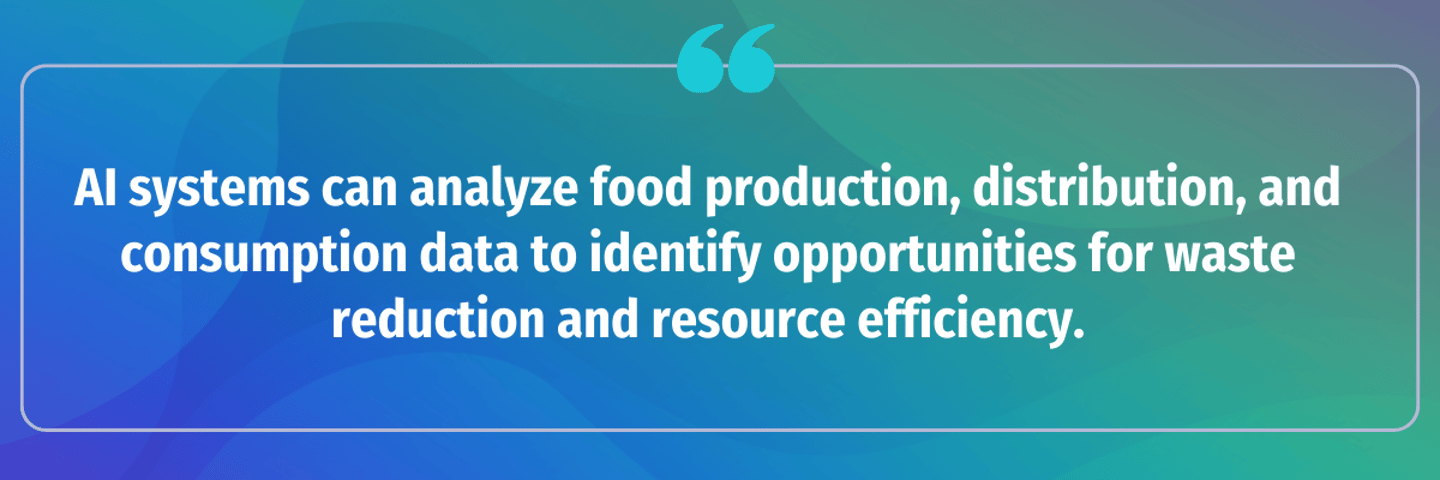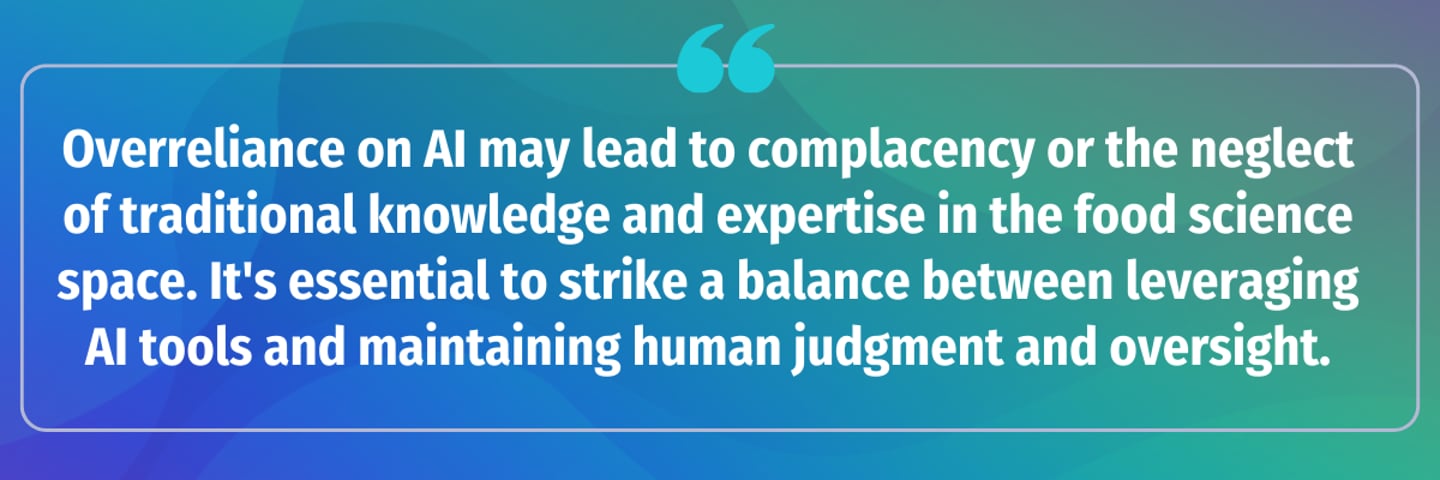The Future of Flavor: Exploring AI's Role in Food Design and Development
With artificial intelligence becoming more mainstream, the food industry is embracing innovative AI technology to stay ahead of the innovation curve. Generative AI, for example, is becoming a powerful tool for businesses to accelerate creativity, fuel efficiency gains, and improve the customer experience.
I recently had the opportunity to explore AI use cases with a group of food science, food safety, quality, product, distribution, and menu/recipe executives — and hence this blog! Let’s explore how AI can accelerate innovation in the food science space.
What is Generative AI?
AI is a way to describe any system that can replicate tasks that previously required human intelligence. Most AI use cases are looking for a probabilistic outcome — making a prediction or decision with a high degree of certainty, similar to human judgment.
Almost all AI systems today are created using machine learning. Machine learning uses large amounts of data to create and validate decision logic, which is known as a model. Deep learning is a type of machine learning that uses a technique known as deep neural networks. These systems replicate how the human brain functions, which allows those systems to address more complex use cases than was previously possible.
And, finally, generative AI is a subfield within deep learning that relies on foundational models that are generative by nature. It focuses on creating content such as text, images, code, and videos through machine learning algorithms. Using deep learning techniques, generative AI operates by producing both original and derived data.
In the food and beverage sector, there are several areas where AI is impacting methods, routines and processes today.
AI in Food Science
AI plays a significant role in various aspects of food science today, revolutionizing research, production, distribution, and consumption in the food industry. AI algorithms analyze large datasets to predict food quality, safety, and shelf life. These models help optimize production processes, reduce waste, and enhance product quality by identifying factors that affect food properties and recommending adjustments to production parameters.
From an innovation perspective, AI-driven platforms can assist food scientists in identifying novel ingredients, flavors, and formulations for product development. By analyzing molecular structures, sensory profiles, and consumer preferences, AI algorithms accelerate the discovery of new food products and optimize their taste, texture, and nutritional content.
From a quality control perspective, AI-powered image recognition systems and machine vision technologies can be used to inspect and sort food products based on quality attributes such as color, size, shape, and defects. These systems enable automated quality control and ensure consistency in product quality.
What about food safety and traceability? AI algorithms analyze data from sensors to detect potential food safety hazards, such as contamination or spoilage. AI-based traceability systems can potentially track the movement of food products from farm to fork, facilitating rapid recall and response in the event of a foodborne illness outbreak.
Upstream, AI enables efficiencies in the growing phase of ingredients. AI-enabled drones, sensors, and satellite imagery can monitor crop health, soil conditions, and weather patterns in real-time, allowing farmers to optimize agricultural practices, reduce resource usage, and increase crop yields sustainably.
One area of interest to the end consumer or shopper is personalized nutrition. AI technologies can analyze individual health data, dietary preferences, and genetic profiles to provide personalized nutrition recommendations. These systems can help consumers make informed choices about their diet, manage chronic conditions, and achieve their health goals.
And for the restaurant or food service outlet, AI algorithms can analyze restaurant sales data, customer reviews, and demographic information to optimize menu offerings, pricing strategies, and marketing campaigns.
Finally, from an environmental perspective, AI systems can analyze food production, distribution, and consumption data to identify opportunities for waste reduction and resource efficiency.
While AI offers numerous benefits to food science, there are also potential risks and challenges associated with its use.
Risks and Considerations for AI in Food Science
AI algorithms may exhibit biases based on the data they are trained on, leading to unfair or discriminatory outcomes. In food science, biased algorithms could result in inequitable access to personalized nutrition recommendations or discriminatory treatment of certain demographic groups in food product development or marketing.
AI algorithms can be complex and opaque, making it difficult to understand how they arrive at their decisions. Lack of transparency and accountability in AI systems may erode trust among consumers and stakeholders, particularly when it comes to issues such as food safety, quality control, and nutrition.
AI systems may produce unintended consequences or unforeseen risks when deployed in real-world settings. For example, automated food production processes could inadvertently lead to the loss of biodiversity, disruption of local food systems, or increased reliance on resource-intensive agricultural practices.
And AI systems rely on vast amounts of data, including personal health information and consumer preferences. Ensuring the privacy and security of this data is crucial to prevent unauthorized access, data breaches, and misuse of sensitive information.
Finally, overreliance on AI technology may lead to complacency or the neglect of traditional knowledge and expertise in the food science space. It's essential to strike a balance between leveraging AI tools and maintaining human judgment and oversight to ensure the ethical and responsible use of technology in food research and production.
Addressing these risks requires careful consideration of ethical, legal, and social implications, as well as proactive measures to mitigate potential harms and ensure that AI technologies in food science are developed and deployed responsibly and ethically.
Technology in Food Science
Technology plays a crucial role in enabling food science by facilitating research, innovation, production, distribution, and safety in the food industry. Advanced analytical instruments such as chromatographs, spectrometers, mass spectrometers, and nuclear magnetic resonance (NMR) machines enable scientists to analyze the chemical composition of foods, identify nutrients, contaminants, and additives, and study their effects on human health.
Biotechnological tools such as genetic engineering, gene editing, and bioprocessing techniques allow researchers to modify crops for improved yield, nutritional content, pest resistance, and environmental sustainability. Biotechnology also enables the production of enzymes, flavors, and food additives through microbial fermentation and bioconversion processes.
For food processing, modern food processing technologies such as high-pressure processing (HPP), microwave heating, ultrasound, and pulsed electric field (PEF) treatment help preserve the nutritional quality, flavor, and texture of foods while extending their shelf life. Advanced sensors and monitoring systems are used to detect contaminants, pathogens, and spoilage in food products.
Finally, traditional data analytics, machine learning, and predictive modeling techniques are employed to analyze large datasets, identify patterns, and optimize food production processes.
Technology, including AI, empowers food scientists and industry professionals to address challenges such as food security, sustainability, and public health while driving innovation and improving the quality and safety of the food we consume.
Justin Honaman is head of worldwide retail and consumer goods go-to-market at AWS.








